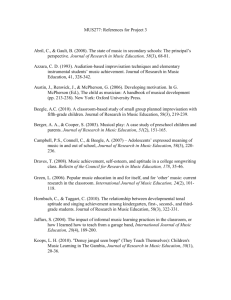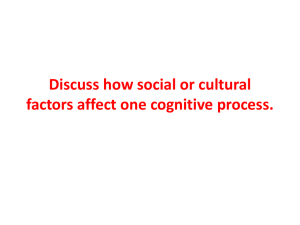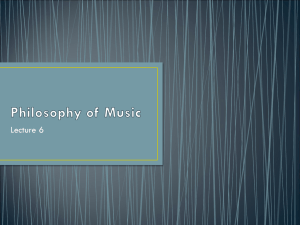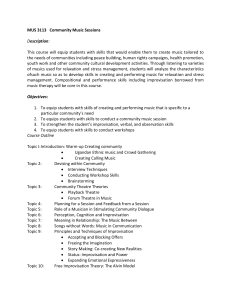Trauma-Informed Music Therapy: Sanctuary Model & Adolescents
advertisement
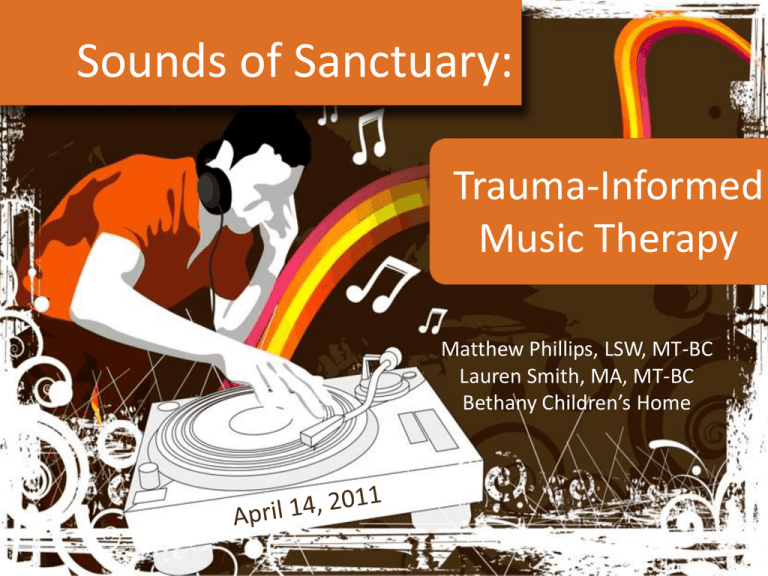
Sounds of Sanctuary: Trauma-Informed Music Therapy Matthew Phillips, LSW, MT-BC Lauren Smith, MA, MT-BC Bethany Children’s Home Outline • Part 1 – Introduction to Music Therapy – Introduction to the Sanctuary Model – Relationship between adolescents and music • Part 2 – Music Therapy Psychoeducation groups • • • • Safety Emotion Loss Future Community Meeting How are you feeling? (play it, then say it) What is your goal for today? Who will you ask for help with that goal? What is Music Therapy? “Music therapy is a goal-directed process in which the therapist helps the client to improve, maintain, or restore a state of well-being, using musical experiences and the relationships that develop through them as dynamic forces of change.” (Bruscia, 1987, In Bruscia, 1998) What is Music Therapy? Music Therapist Client Why Use Music? • Culturally-relevant • Met with less resistance than strictly verbal interventions • Less threatening means of self-expression • Flexible medium that can be adapted in the moment • Access to nonverbal, fragmented trauma memories Training of a Music Therapist • Bachelor’s, Master’s or Doctoral degree in music therapy • Practica and Internship • MT-BC – Music Therapist Board Certified Bethany Children’s Home Types of Music Experiences Listening Composition Re-creating Improvisation Listening Experiences Definition • Receptive musical experience • Live or recorded musical example • Help the listener establish personal connections or points of discussion with the lyrical or instrumental content • Evokes emotional responses • Supports an image-driven relaxation experience Listening Experiences • • • • Goals Establish personal connections with lyrical or musical content Identify points of discussion Evoke and support emotional responses Support an image-driven relaxation experience Re-Creating Experiences Defined • The client learns or performs a precomposed vocal or instrumental piece – Performance - to share with others – Non-performance – Group Sessions – Individual sessions Re-Creating Experiences Goals • To develop appropriate social skills • To improve attentiveness • To develop leadership and teamwork skills • To develop and utilize coping skills • To increase self-esteem and self-expression • To share talent and strengths with the BCH community • To create a shared and meaningful music experience within the BCH community Composition Experiences Defined Composition is a process that fosters emotional awareness, cognitive understanding and creative expression through musical means such as lyric writing, lyric substitution, instrument playing and accompaniment Composition Experiences Goals • To develop organizational and planning skills • To promote self-responsibility • To develop the ability to document and communicate inner experiences • To promote the exploration of therapeutic themes through lyrics • To develop the ability to integrate and synthesize parts into whole (Bruscia, 1998, pp. 119-120) Composition Experiences “My Journey” Verse 1 Started out really early, young and so afraid No one would have realized because attention I wasn’t paid Stopped every dream I had, so I could play Mom and Dad Everything I wanted was never what I had Chorus Sometimes it’s smarter to push your own way though Because some things you need, may not be handed to you I learned the hard way, trying to help everyone succeed And at the end of the day I had no one to count on but me Composition Experiences Verse 2 “My Journey” Then I found myself all alone, in a place so unreal Seemed like what I ever felt was no longer what I could feel I tried to hide my fear in a search for a way out But when I reached for help is when I figured it out Chorus Sometimes it’s smarter to push your own way though Because some things you need, may not be handed to you I learned the hard way trying to help everyone succeed And at the end of the day I had no one to count on but me Composition Experiences “My Journey” Verse 3: Now I’m in a better place and my dreams will soon come true I learned from the mistakes and situations I’ve been through I have myself to love, and that is how it will always be It’s not hard to realize how much this place has changed me Chorus: Sometimes it’s smarter to push your own way though Because some things you need, may not be handed to you I learned the hard way trying to help everyone succeed And at the end of the day I had no one to count on but me Composition Experiences “Trapped” To all my people in the struggle For all my people who feel trapped Can’t get anything out For all the hard times All the long days Can’t think of nothing To free their soul Composition Experiences “Trapped” Trapped in these walls and it feels like I can’t breath Trapped in these walls and I can’t break free All my anger grows up inside I can never go to a place where I can just hide Cause my heart beats faster and I start to sweat I know I’m nowhere finished with this yet Is it the motivation that wakes me up in the morning Or is it the dedication that makes this not boring Is it the hope that helps me find my way Or is it the fear that I fear every day Composition Experiences “Trapped” I feel like a new person With every step that I make I’m doing all these things And I can never get a break Trapped in these ways And I can’t tell where I am But maybe one day I can understand Why I’ve been trapped for all these years It gets me so mad It almost brings me to tears I’m living in a body, living in a world that’s fake I have one way out And it’s not yours to take Improvisation Experiences Defined • Creating music in the moment in response to individual feelings and/or a collective group intention – Nothing is written down – No “mistakes” – Percussion Instruments - fun and accessible – Other Instruments Improvisation Experiences Goals • To establish nonverbal communication • Provide a fulfilling means of selfexpression and identity formation • Explore various aspects of self in relation to others • Develop group skills • Develop creativity, expressive freedom, spontaneity and playfulness with various degrees of structure (Bruscia, 1998, p. 116) Improvisation Experiences What is Trauma? An overwhelming event that causes intense feelings of fear, helplessness or horror. There are many different kinds of trauma and not everyone responds the same way to a traumatic event. (Sanctuary Staff Training, Module 1) What is Sanctuary? • Trauma-informed model of care • The shared language of S.E.L.F. – Staff Training – Psychoeducation Groups • Seven Commitments • Toolkit – – – – Staff Training Core Team Red Flag Reviews Psychoeducation Groups A Change in Perspective Sickness Model “What’s wrong with you?” vs. Injury model “What Happened to You? Sanctuary Commitments • Nonviolence • Emotional Intelligence • Social Learning • Shared Governance • Open Communication • Social Responsibility • Growth and Change S.E.L.F. Safety Future Emotion Loss S.E.L.F. • A way of organizing complexity • Dynamic and nonlinear • Phases you move in and out of (not stages you climb) • An accessible language • Gets everyone on the same page • Applicable to children, adults, families, staff, organizations Adolescents and Music “How does loud music calm him down?” • Music is not a “universal language,” but it does foster connectedness • Iso Principal - Music first matches the mood and slowly changes to shift to the desired mood state (Safety Plan CD) • Delayed gratification - release from the discomfort comes only after fully being present with the discomfort (Sad songs can ultimately cheer you up) Adolescents and Music “Violent songs make violent kids” • Music plays a reflective (not a causative) role during adolescence • Music functions as a window through to the internal state of the teenager • Music can be used to increase personal understanding (“Lil’ Wayne is the only one who gets me”) (McFerren, 2010) Intermission • Where we’ve been: Foundations • Music Therapy • Sanctuary • Adolescents and Music • Where we’re going: MT Psychoeducation Groups • Safety • Emotion • Loss • Future Safety Physical Psychological Social Moral Safety • Physical, Psychological, Social Moral • Music is safe - teaches about safety and provides a safe environment • Popular songs address themes of safety • Music provides a safe container and context for the experience • Youth begin with discussing safety issues in the music, and gradually move to processing personal experiences Safety “Welcome to My Life” by Simple Plan • Lyric discussion and songwriting experience • Teaches the four domains of safety: physical, psychological, social and moral Safety “Being in my Life” by BCH Youth To be loved, to feel wanted To be free in the world To be glad when you’re sad It feels like you’ve been in love To be on the edge of everything and strength is there to save you Now you do know what it’s like Being in my life Safety “Use It” Music Video • Outside of Psychoeducation Groups • Girl’s Cottage (Ages 15-19) worked with houseparents, MT, SW, CTRS • Chose music, wrote lyrics, recorded the song, staged and filmed the video Emotion Management • Cultural instinct prompts adolescents to listen to music when experiencing distress • Identify current means of managing emotions and meet the youth where they are • Teach new means of managing emotions Emotion Management Improvisation • Group Improvisation – Play emotions together – Adjust the “volume” of the emotion • Solo Feelings Improvisation – Like a charades game, using emotion cards – Relate to community meeting Emotion Management Music-Assisted Relaxation • Music is a cue and a context for progressive muscle relaxation and guided imagery • Relaxation is a learned skill • Unique responses of each individual • New Age music with minimal movement is very holding • Beware of classical music, as it will always move the client somewhere else Loss • Loss is uncomfortable, but music can make it safe to explore – Time-ordered Structure – Projective Tool – Promotion of Universality • Music can elicit complex responses Loss Re-enactment Triangle Perpetrator Victim Rescuer Loss Autobiography in Five Short Chapters • Sound Poem with structured instrument playing • Underline colors indicate when each instrument plays • Gives words a musical (emotion) context Future • Themes of popular music - thinking about future and working together to make the world a better place • Make change within the group and generalize to experiences outside of the group Future “The Kids” by B.o.B. • Multi-layered lyric discussion and songwriting • • • • experience that focuses on making a change for a healthy future Listen to the song and identify important themes Two-sided fill in the blank handout “The Kids Don’t Stand a Chance” “The Kids Do Stand a Chance” Future Adapted from “The Kids” by B.O.B. Our boys and girls have choices The streets are not their home They’re filled with hopeful voices Our kids do stand a chance They’re free to choose their future Inspired to live their dreams They’re filled with expectations Our kids to stand a chance I said our kids do, our kids do stand, Our kids do stand a chance Future “Man in the Mirror” by Michael Jackson • Summer training for all staff • • and youth Staff and youth worked together to rewrite lyrics based on theme of “Growth and Change” Staff and youth reflecting on the growth and change within the campus community Community Interventions • Religious Services - choir, world music • • • drumming, solos, small groups Talent Shows and Coffee Houses Occasional Community Performances Special Events - Anniversary Day Non-Music Therapists • Know your strengths and limitations • The non-therapist musician and the nonmusician therapist bring very different skill sets • Be aware of music’s capacity to elicit intense response (particularly in relation to loss) • Know your population and their unique characteristics • Extensive training is required to interpret client musical responses • It’s not music therapy without a qualified music therapist Final Thoughts “Teenagers relate to music. Music plays an important role in society. Musical engagement can be health promoting. And most importantly, music can be fun. Just show me a teenager who doesn’t want to be happy.” (McFerren, 2010, p. 74)
